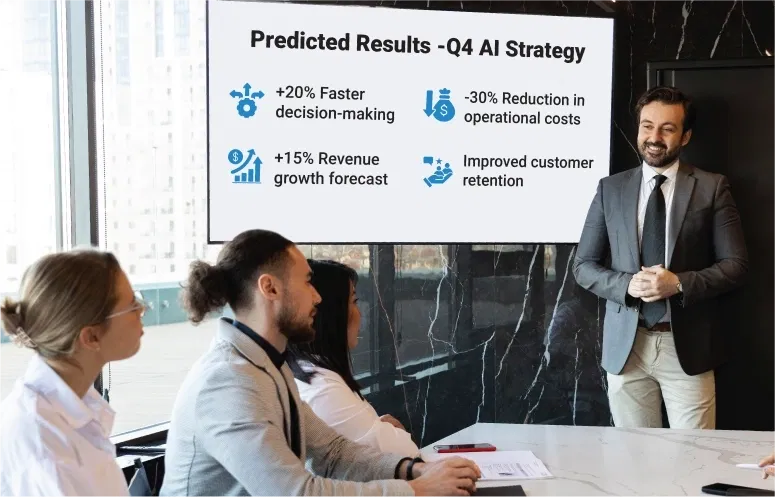AI fraud detection isn’t just a theory; companies worldwide are using it. Fraudulent activities have grown into a complex threat, extending far beyond financial losses—they can erode customer trust, damage brand reputation, and result in costly regulatory penalties.
Fraud scams and bank fraud schemes resulted in $485.6 billion in losses globally last year, according to Nasdaq’s 2024 Global Financial Crime Report.
From safeguarding online transactions to protecting sensitive data, staying ahead of sophisticated fraudsters has never been more critical. Fortunately, artificial intelligence (AI) has emerged as a powerful technology.
By leveraging advanced machine learning algorithms and predictive analytics, AI identifies and mitigates threats with unprecedented speed and accuracy to continuously adapt new fraud tactics. This has positioned AI as an indispensable tool, safeguarding financial transactions and instilling confidence in businesses and consumers. Let’s explore the role of AI in making online transactions safer.
The rising threat of payment fraud to be aware of
Digital transactions are revolutionizing the financial landscape, and the menace of payment fraud is rapidly increasing. This presenting formidable challenges to enterprises, financial institutions, and individuals. As the proliferation of online transactions increases, so does the ingenuity of fraudsters, who relentlessly innovate to exploit the evolving intricacies of payment systems. The factors driving this growing threat are:
- Expansion of digital payment platforms
- Increased transaction volume
- Use of AI by hackers
- Regulatory challenges
- Synthetic identity fraud
Source:https://campaign.grantthornton.in/l/991702/2024-06-25/35d2t/991702/1719308925cSJNephv/Financial_and_Cyber_Fraud_Report_2024.pdf
Impact on businesses and consumers
Fraud not only results in direct financial losses but also has broader implications:
- Financial losses
- Reputational damage
- Operational disruptions
- Increased costs
Let’s explore the types of fraudulent activities and expected loss:
| Fraud Type | Expected Loss | Date |
| Global online payment fraud losses | $91 billion | 2028 |
| US eCommerce fraud totals | $48 billion | 2023 |
| Global eCommerce payment fraud losses | $343 billion | 2023 -2027 |
| Global AI fraud loss (conservative scenario) | $1 trillion | 2030 |
| Synthetic Identity fraud | $23 billion | 2030 |
| Credit card losses | $43 billion | 2026 |
| Total amount of regulatory fines against institutions for KYC failures (including money laundering) | $5 billion | 2022 |

3 key use cases of generative AI for the financial industry
The adoption of generative AI in financial sector makes a substantial impact in detecting financial fraud. It analyzes vast amount of data in real time, enhance security measures, and increase customer support and security.
The role of AI in fraud detection for increased precision and efficiency
Real-time transaction monitoring
AI offers significant advantages in fraud detection by analyzing vast amounts of transactional data in real time. Unlike traditional systems that rely on static rules and respond slowly to new threats, AI uses machine learning algorithms to identify patterns and anomalies, quickly recognizing suspicious activities. This capability for real-time monitoring allows for immediate intervention, preventing fraudulent transactions before they inflict damage.
Predictive analytics and pattern recognition
AI excels at identifying patterns within complex datasets, making it highly effective at predicting and preventing fraud. By analyzing historical data, AI models uncover subtle correlations and trends that might indicate fraudulent behavior. These predictive analytics capabilities allow AI to forecast potential fraud scenarios and implement proactive measures, thereby reducing the risk of fraud before it occurs.
Enhanced accuracy and reduction of false positives
A common challenge in fraud detection is false positives, where legitimate transactions are flagged as fraudulent. AI improves accuracy by analyzing a wider range of data points and context, allowing it to better distinguish between genuine and fraudulent transactions. This precision enhances security and reduces unnecessary disruptions, improving the user experience.
Behavioral biometrics
AI-powered behavioral biometrics is a cutting-edge fraud detection method that analyzes unique user behaviors like typing speed, mouse movements, and interaction patterns. By creating a behavioral profile for each user, AI can detect deviations that may indicate fraud, adding a layer of security that is hard for fraudsters to replicate and effective against account takeovers and identity theft.

How artificial intelligence in investment management will give you an edge
The key enterprises applications of AI in investment management are to scrape smartphone reviews from various websites and extract themes to highlight essential topic and trends.
How fraud detection using AI is making banking and financial transactions safer
- Identifying fake accounts: AI detects synthetic identities or fake accounts created using a mix of original and fabricated information. It analyzes account behavior and background data, allowing banks to identify and prevent these fraudulent accounts from causing harm.
- Preventing money laundering: Artificial intelligence analyzes transaction patterns to spot potential money laundering activities. It compares transactions against known laundering techniques and flags suspicious patterns for further investigation.
- Phishing attacks: AI helps detect phishing attempts by analyzing email patterns and content to identify fraudulent messages that attempt to steal sensitive information. AI system filters the message and alerts the users to suspicious communications, reducing the risk of successful phishing attacks.
- Credit card theft: The technology identifies patterns consistent with credit card theft, such as unusual spending or transactions from locations not previously associated with the cardholder. This real-time analysis allows banks to flag or block potentially fraudulent transactions.
- Document forgery: AI tools can analyze documents for signs of forgery by comparing them with known genuine documents and identifying discrepancies. This helps to detect and prevent the use of forged documents for fraudulent purposes, such as opening fake accounts or applying for loans.
- Fraudulent loan applications: AI analyzes loan applications for inconsistencies or red flags that might indicate fraud. By evaluating the application data against historical patterns and known fraud indicators, AI helps prevent fraudulent loan disbursements.
- Unusual transaction patterns: AI can detect unusual transaction patterns that deviate from a user’s historical behavior, such as sudden large transactions or transactions in unusual locations. These anomalies are flagged for further review or automatic action.
The future of AI in fraud prevention
1. Enhanced detection capabilities
AI algorithms are becoming more advanced in analyzing vast amounts of data to detect anomalies and suspicious patterns. Machine learning models, particularly those utilizing deep learning, can recognize subtle deviations from normal behavior that traditional systems might miss. The ability to process and analyze data in real time enhances the accuracy of fraud detection and reduces the chances of false positives.
2. Adaptive learning
One of AI’s most significant advantages is its ability to learn and adapt. Fraud tactics are continuously evolving, and static fraud prevention systems can quickly become obsolete. AI-powered systems, however, use adaptive learning to stay ahead of emerging threats. By continuously training on new data and adjusting algorithms accordingly, AI can evolve alongside the fraudsters’ tactics, improving its effectiveness over time.
3. Behavioral analytics
AI in financial operations enhances fraud prevention by analyzing user behavior patterns. By establishing a baseline of normal behavior for each user, AI systems can detect unusual activities that deviate from the norm. For example, if a user who typically logs in from a specific location suddenly accesses their account from a different country, AI can flag this as a potential fraud risk and trigger additional verification steps.
Real-life use cases: AI preventing fraud enhances payment strategies
JP Morgan
The global financial leader, JP Morgan, has implemented an AI system known as DocLLM to enhance their fraud detection capabilities. This system leverages advanced natural language processing and machine learning techniques to swiftly analyze vast amounts of legal documents. In just a few seconds, DocLLM can sift these documents to identify inconsistencies, anomalies, and warning signs that might indicate fraudulent activities.
This proactive approach helps the bank mitigate risks, protect its assets, and maintain trust with its clients by preventing fraudulent transactions before they can cause significant harm.
Mastercard
Mastercard’s AI-based platform, Decision Intelligence, plays a critical role in fraud prevention. It uses generative AI to analyze cardholder spending patterns in real time, evaluating the likelihood of fraud for each transaction as it occurs.
The integration of AI technology has greatly enhanced the security of Mastercard’s payment network. The platform’s efficiency is evident, as it has already helped Mastercard “score and safely approve 143 billion transactions a year,” providing a robust layer of protection for cardholders and the company itself.
Capital One
Capital One has integrated AI into its customer service strategy through Eno, a virtual assistant launched in 2017. It is designed to interact with users via mobile apps, text messages, email, and desktop. It allows answering customer questions, sending fraud alerts, and handling routine tasks like paying credit card bills, tracking account balances, and checking transactions.
What sets Eno apart is its ability to communicate in a natural, human-like manner, even incorporating emojis into its responses. This makes interactions with the AI feel more personal and engaging, enhancing the overall customer experience while ensuring that essential banking tasks are handled efficiently and securely.

Autonomous AI Agents for Finance: The future is now
The future of finance is autonomous as AI agents help finance leaders focus on strategic tasks, drive innovation by identifying new opportunities, influence change, align goals, and drive value.
Suggested: Autonomous AI Agents for Finance: The future is now
Leverage Softweb’s AI-driven solutions for fraud detection and prevention
In 2024 and beyond, banks and financial institutions are set to enhance their fraud prevention strategies by investing in advanced analytics and harnessing the transformative potential of AI. This approach will boost efficiency and effectiveness in detecting fraud.
Adopting a risk-based methodology, managing alerts, evaluating various scenarios, and responding quickly to emerging threats can create a secure environment for digital transactions. Softweb’s AI consulting services offer end-to-end solutions such as:
- Strategic development to deployment and maintenance
- Analysis of market trends
- Risk management and compliance
- Fraud detection and prevention strategy
- Customer segment and personalization
Contact our AI consultants to discuss your use case.



